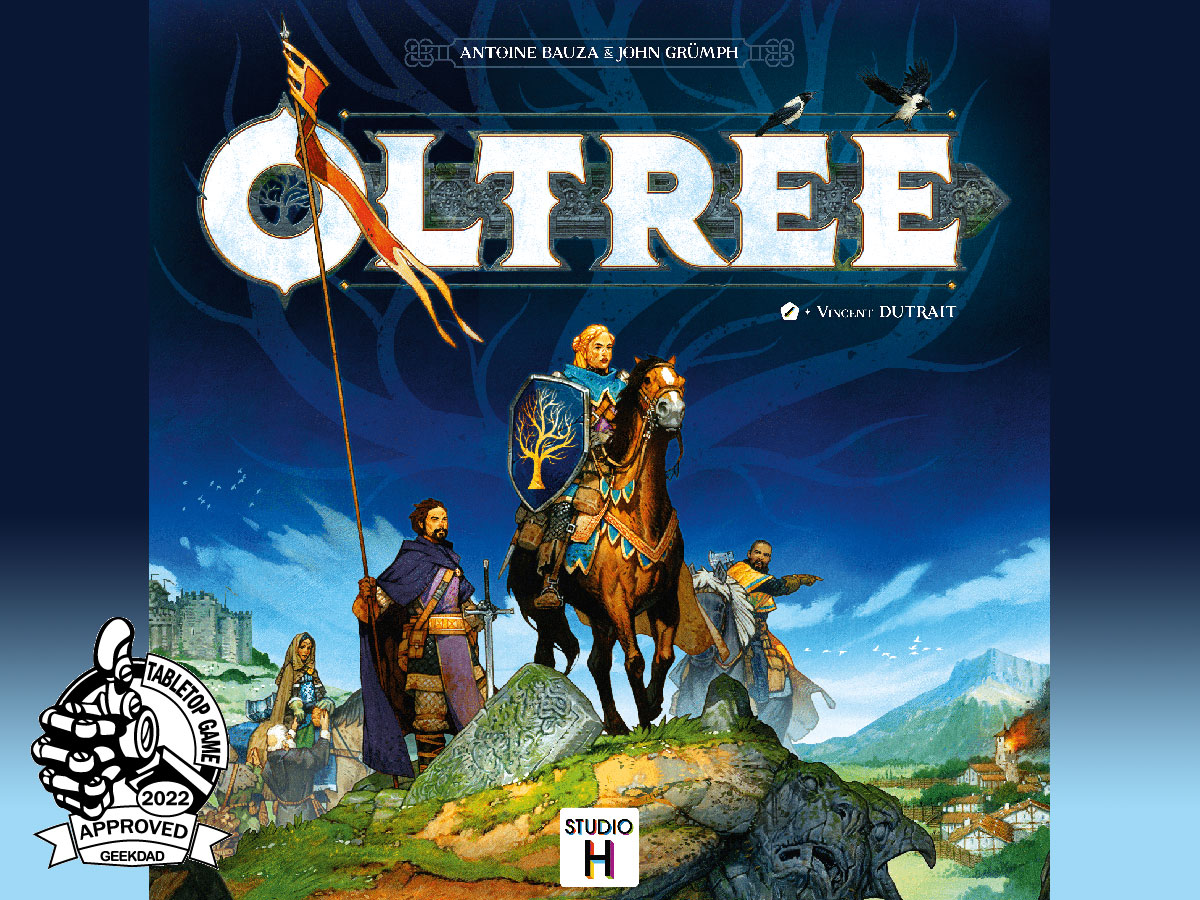The empire has fallen, but the Rangers are still at work, repairing the fortresses and protecting the communities around them.
What Is Oltréé?
Oltréé is a cooperative story-based game for 2 to 4 players, ages 10 and up, and takes about an hour to play. It retails for $69.99 and is available in stores and online. The game takes place in a fantasy setting, with mythical creatures and monsters; there’s a good dose of humor so it shouldn’t be too scary even for younger kids, and it’s actually simpler than it might appear from the setup. Since it’s cooperative, younger kids may be able to join in with more experienced players, but I will note that there is a good bit of reading.
Oltréé was designed by Antoine Bauza, based on the Oltréé role-playing game by John Grümph. It is published by Studio H and distributed in the US and UL by Hachette Boardgames, who provided me with the review copy. Vincent Dutrait illustrated the bulk of the game, and the various chronicles also include illustrations by Jérôme Lereculey, Ivan Gil, Ronan Toulhoat, and Albertine Ralenti.
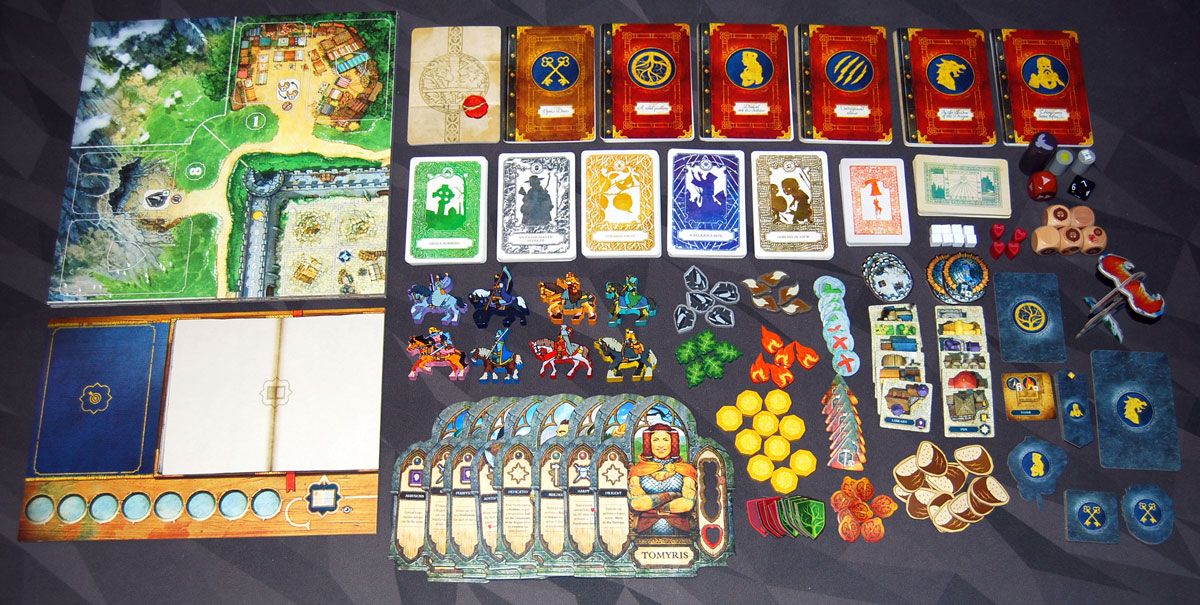
Oltréé Components
Here’s what comes in the box:
- Main board
- Side board
- 100 Incident cards (20 each in 5 colors)
- 25 Event cards
- 25 Problem cards
- 69 Chronicle cards
- 11 Assignment cards
- 16 Building tiles
- 5 Profession dice
- Adversity die
- Location die
- 8 Shield tokens
- 12 Provision tokens
- 8 Ranger cards
- 8 Ranger figurines
- 4 Health tokens
- 30 Resource tokens (5 each stone, plant, fur, and fire; 10 treasure)
- 8 Status tokens
- 8 Goal tokens
- 8 Success markers
- Adversity marker
- Prestige marker
- Defense marker
- 8 Damaged markers
- Chronicle tokens

The components in Oltréé look gorgeous, not only because of Vincent Dutrait’s artwork but also for the quality of the components. The wooden tokens are chunky, but with detailed shapes, and have a glossy finish. The wooden dice are oversized, and the cardboard tokens have nice illustrations on them. It really feels like the sort of thing you’d expect from a deluxe edition, which also explains the premium sticker price. When it comes to upgrades that aren’t strictly necessary, I find that I much prefer fancy colorful wooden pieces to a big pile of plastic grey miniatures. The only two components that stand out as kind of boring and standard are the location die (a standard d8) and the success markers, which are plain white wooden cubes.
The board itself shows a bird’s-eye view of a partially crumbled fortress, surrounded on all sides by various regions: a market, a farm, a lumber mill, and so on. There’s plenty of room for the various cards and buildings that will be placed on the board. The side board has spaces for the various card decks as well as the adversity track, which determines what complications pop up throughout the game.

The ranger boards feature a cut-out health track and the ranger’s name and special ability; the majority of the board is taken up by a large portrait—again, something that isn’t entirely needed for the game, but it gives you a nice look at your character.

The ranger figurines are extra-large meeples depicting the rangers on their horses; the base color matches the little “gem” on the ranger board, and both sides of the meeple are printed with a simplified graphic of the ranger. They’re very colorful and look great on the board.
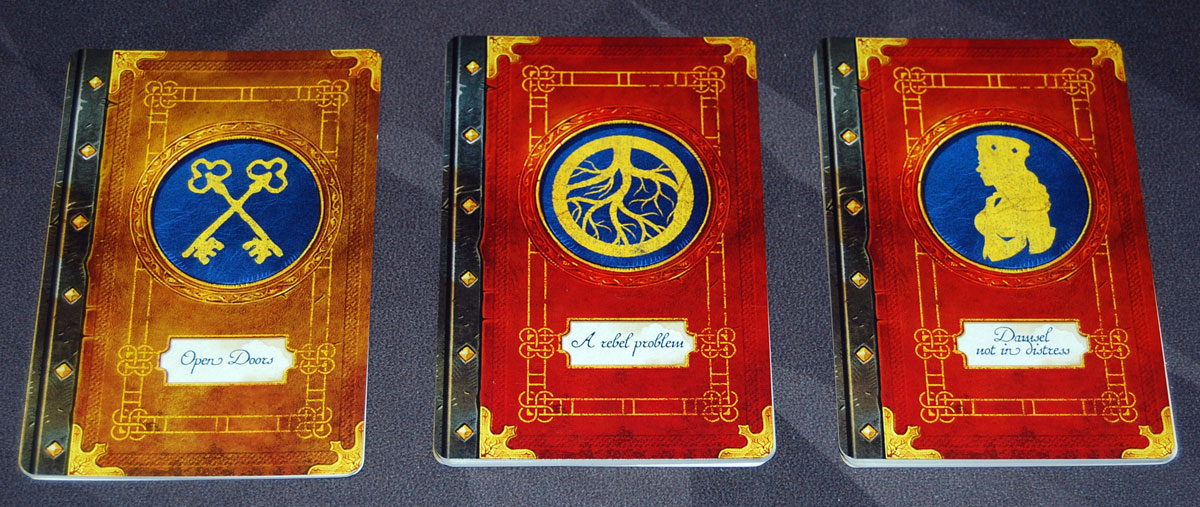
There are a few different sizes of cards: the chronicle and assignment cards are the largest of the bunch, the height of tarot cards but a little wider. The chronicle decks are made to look like a book, with a front cover and title, and then the cards act as “pages” as you progress through the chronicle.

The incident cards are next up, about the width of standard bridge cards but taller. Each of the five decks has its own theme: rural life, creatures, lands, encounters, and mysteries. The backs have a silhoutted illustration with a title that hints at what you might find, and the front has a brief story and either a skill check or a choice to make.
Finally, there are the problem cards and event cards, which are the smallest of the bunch. but they’re still larger than those typical mini cards you find in many Euro games. The “slightly larger than usual” size of the cards is definitely part of what gives the game its deluxe feel.
I didn’t list out all of the chronicle-specific tokens, but there are various tokens that will only be used for a specific chronicle—as you work your way through the pages, you’ll be instructed to find these when appropriate. Most of them have a little icon on the back that corresponds to the chronicle, but there are some that are printed on both sides (like the dragon standee) and don’t have an icon.

The box itself is also a fun surprise: it has a cardboard insert, but with flaps that cover up four different compartments, also with Dutrait’s illustrations on them. It’s actually a pretty simple design and it keeps the cards organized without having to bag them, and doesn’t require a lot of plastic. It’s still easier to keep things sorted if you do bag up some of the tokens, but the lids keep things from floating around in the box.
How to Play Oltréé
You can download a copy of the rulebook here.
The Goal
Each chronicle has its own goal, but generally you’re trying to achieve as many goals as you can on your assignment, while also dealing with whatever the chronicle tasks you with.
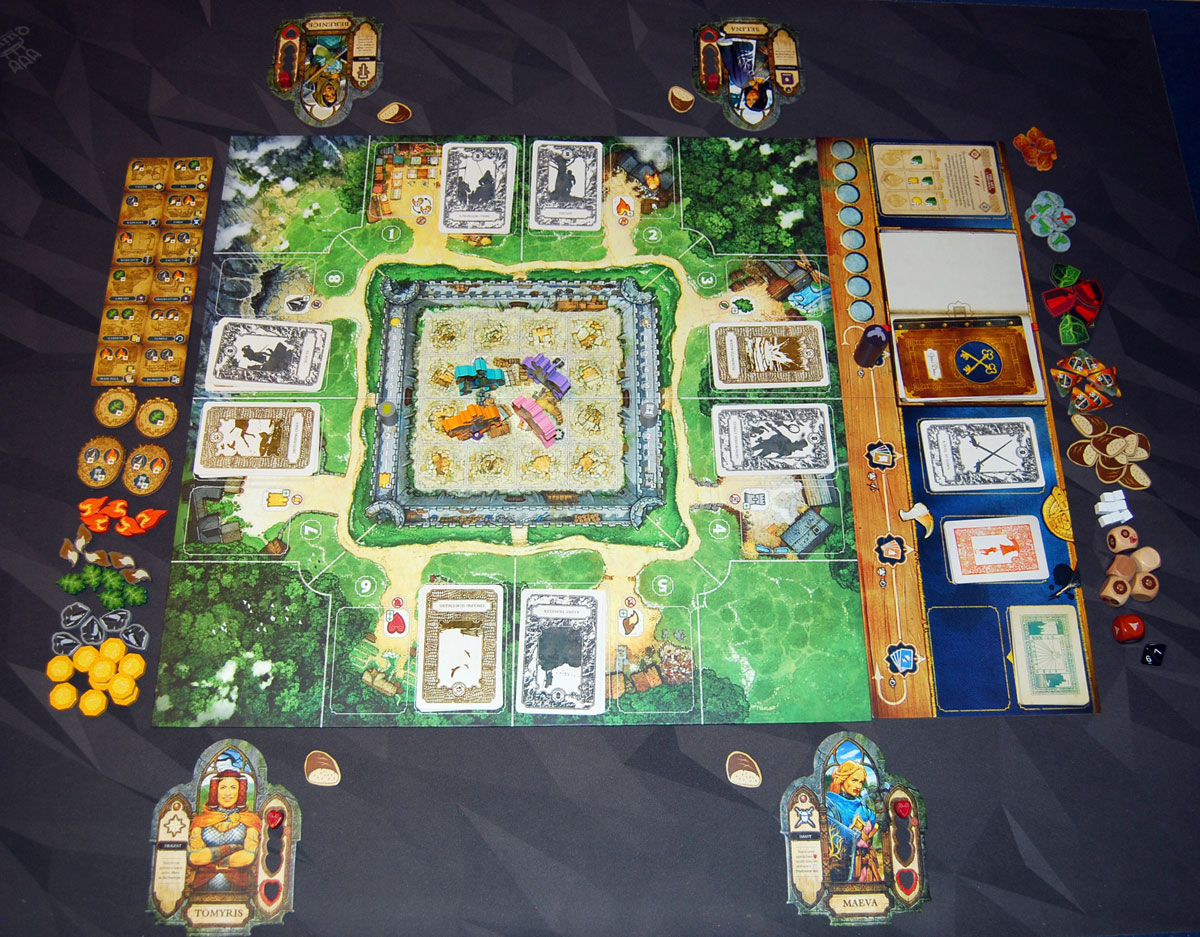
Setup
Lay out the main board and the side board. Choose an assignment card and a chronicle. There are three difficulty levels for the assignments, with a few options for each. There are 6 chronicles included in the base game; “Open Doors” is a shorter introductory chronicle, and the rest are full-length. Put the assignment card and the chronicle deck on the side board.

The assignment card will indicate two of the incident types to use—take those two decks, shuffle them together, and place them on the side board. Deal 3 cards face-down to each large space on the main board. Shuffle the problem deck and the event deck and place those on the side board as well. Place the adversity marker on the first space of the track, and place the defense and prestige markers on the “3” spaces of their tracks (along the sides of the fortress).
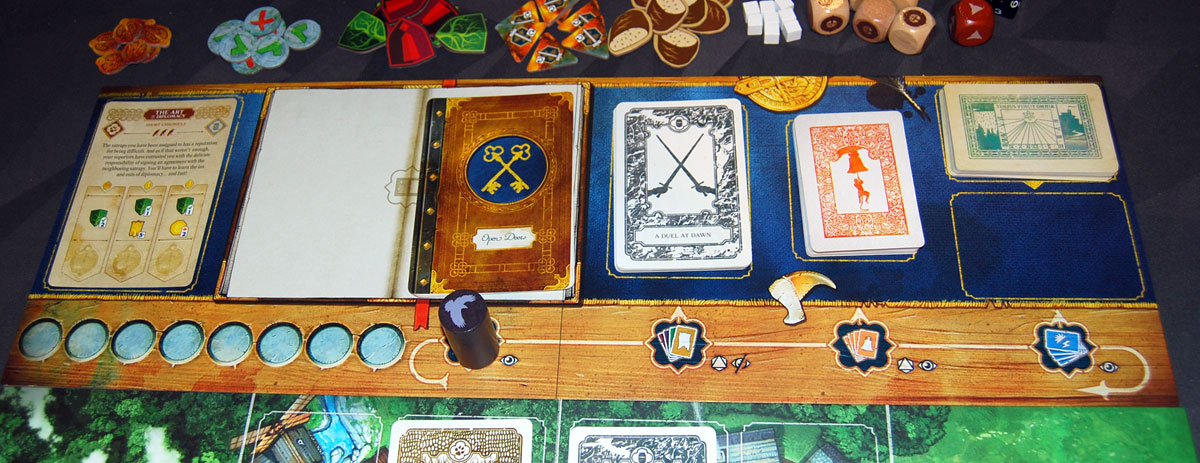
Each player chooses a ranger and takes the board, one provision, and a health marker. Place the matching ranger figurine in the fortress. If playing with fewer than 4 players, you will start with 1 or 2 buildings in the fortress. Set the rest of the buildings and various tokens and markers nearby.
Flip open the chronicle and read the introductory chapter.
Gameplay
On your turn, you will roll the adversity die and resolve it, and then take 2 actions.
Adversity Die
The adversity die determines how many spaces to move the marker, usually one space, but occasionally 2 spaces or not at all. The one note is that it can never stay on the chronicle space, and it can never skip over the chronicle space. The four spaces are: chronicle, incident, problem, and event.

Chronicle
Each time the marker passes the end of the track, it returns to the chronicle space, and you flip the next page of the chronicle and read it. This will give you another chapter of the story, and may also give you some instructions to follow immediately, or another action that you can take while this page is showing, or other effects.

Incident
When the marker lands on the incident space, first check how many regions are in peril (with the red shield token) and lose 1 prestige for each perilous region. Then, roll the location die: if that region is secure (a green shield) or perilous, do nothing; otherwise, place the next incident card on top of that region. If the region now has 4 incident cards, place a red shield on it.
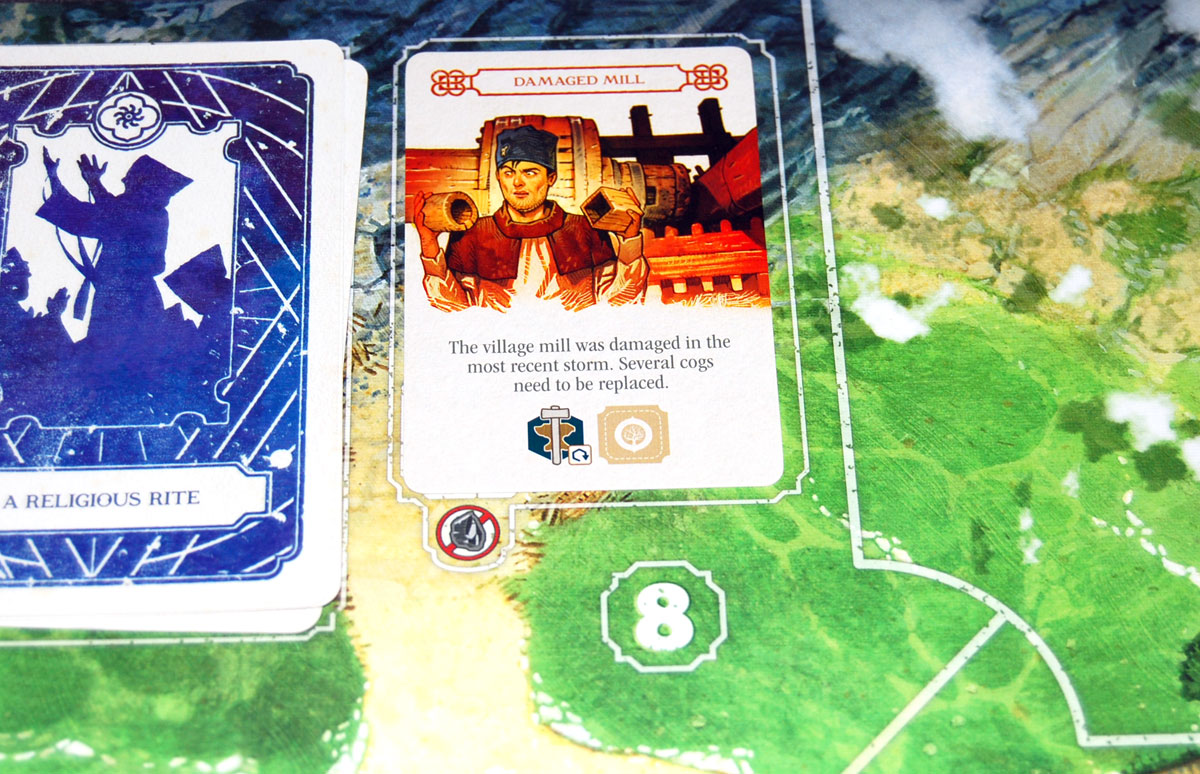
Problem
Roll the location die, and then draw the next problem card and place it face-up in that region’s problem space, reading it aloud. If there’s already a problem there, go to the next clockwise open space. If there aren’t any open spaces, lose a prestige and do not add a new problem card.
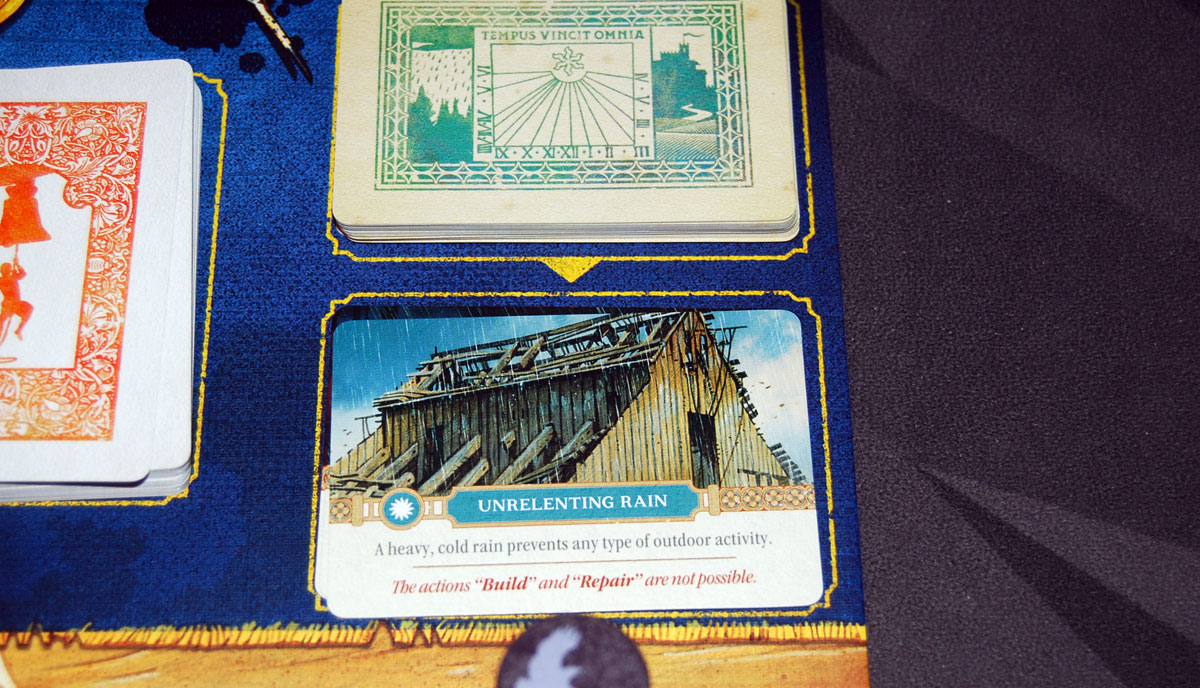
Event
Flip over the next event card and read it. Cards with a lightning bolt cause a one-time immediate effect. Cards with a sun are persistent and have ongoing effects until the next event card is drawn.
Take 2 Actions
You then take two actions, which must be different from each other. Your options are:
- Move
- Rest
- Call on a community
- Handle a problem
- Experience an incident
- Build/repair a building/tower
- Ranger ability
- Temporary action
Moving is simple: move from one zone to an adjacent zone. The fortress counts as one single region and is adjacent to all of the surrounding regions.
To rest, increase your health by 1 and take 1 provision. You have a maximum of 3 provisions. You may spend a provision to re-roll any number of profession dice on a check, or spend 2 provisions to gain a bonus action on your turn (which may repeat an action you’ve already done).

If you are in one of the regions, you may call on the community for its ability, as long as there is not a problem there (which covers up the ability). The various regions will let you collect or trade resources (stored in the fortress), gain defense or prestige, or heal yourself fully.

To handle a problem in your current region, you must pay the listed resources or do the indicated profession check. If you pay the resources, the card is removed. Some problems with checks require more than one success—mark these with the white cubes, and when the track is filled, the card is removed. To do a profession check, you roll one die for each icon you have matching that profession. The fortress starts with one of each icon, and your ranger board has an icon as well. As you build buildings, some of them will add profession icons as well. The dice have blank faces (failure), a tree icon (success), or a tree with a heart icon (you may lose 1 health to gain a success).
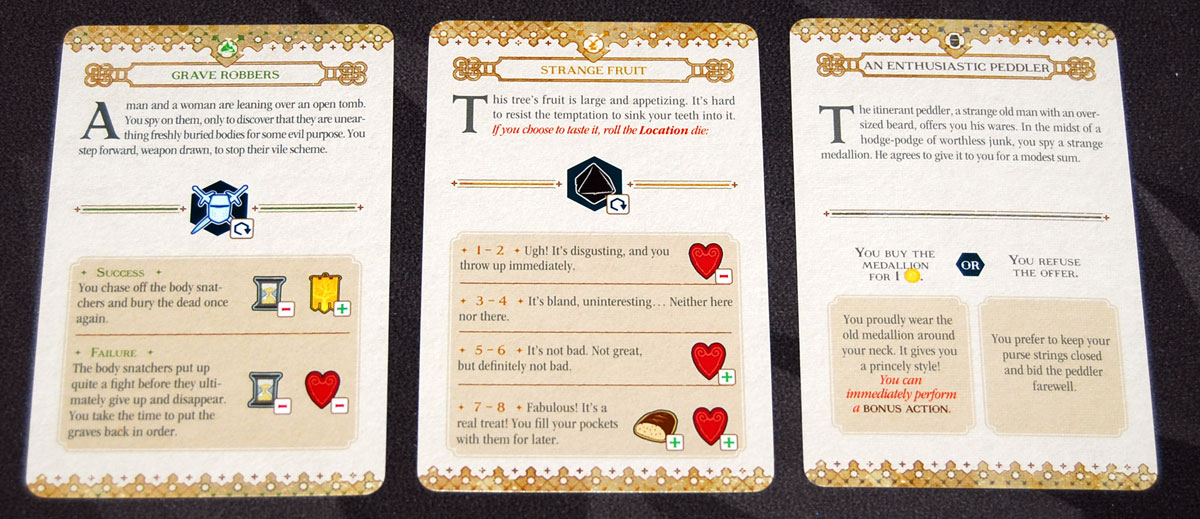
If you want to experience an incident in your region, draw the top card and give it to the player to your right without looking at it. They read the story aloud to you, and then tell you what you need to do. In many cases you will need to perform a profession check (as described above), but some incidents may just give you a choice between two options, or they may check something like how much prestige you currently have, or how many problems are currently on the board. Whether you succeed or fail at a profession check, the incident card is then discarded.
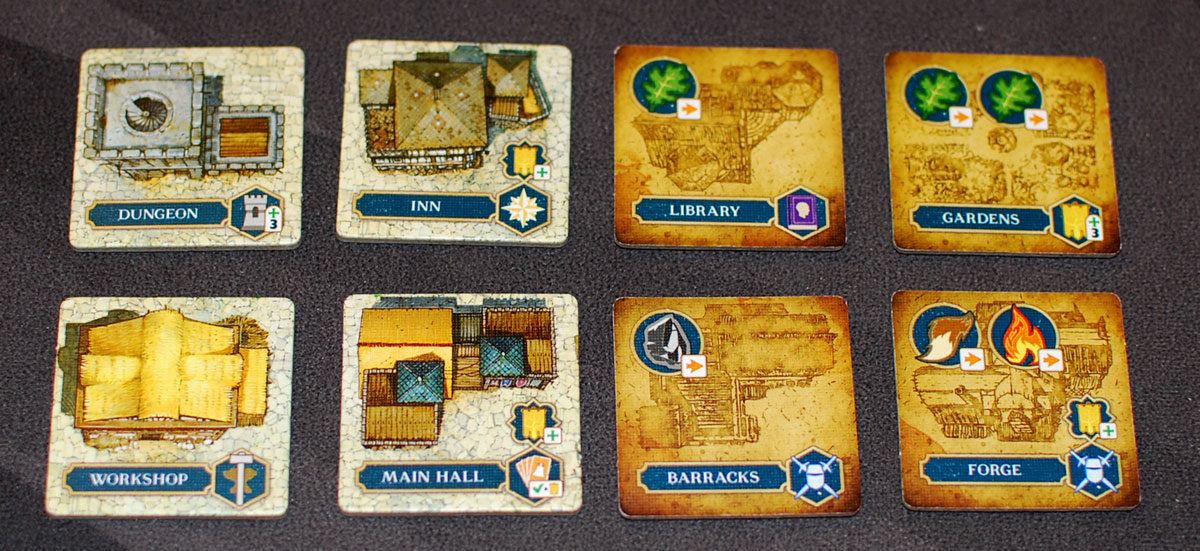
If you are in the fortress, you may build a building by spending the necessary resources. Place the building in one of the spaces along the wall of the fortress. Some buildings immediately provide an increase in prestige or defense. Towers are placed on the four corners of the fortress, and each one can protect the two regions it is adjacent to. At any point, if a region has no incidents and there is a tower built there, the region is secure and you place a green shield on it. Buildings can become damaged by events or incidents, in which case they are marked with a damage token, and any benefits they provided (including bonus prestige or defense) is lost; players may take a craftsman profession check to remove the token. (A damaged building that gets damaged again is removed.)
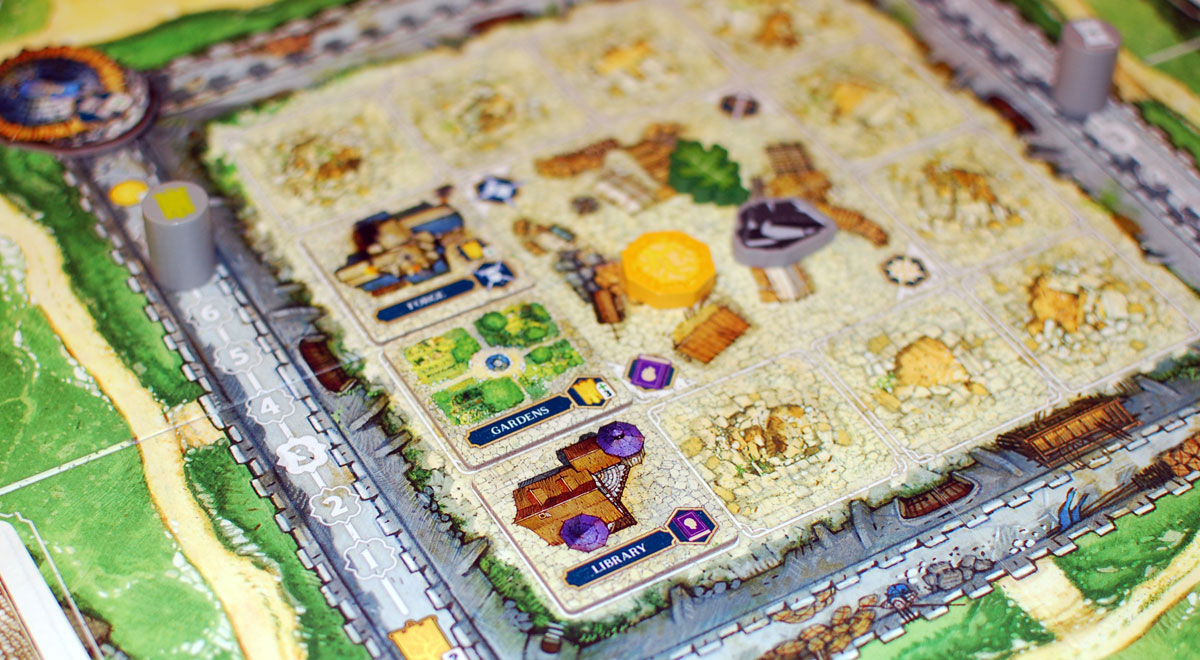
Some rangers have special bonus actions they can perform in addition to their two regular actions. There are also actions that may appear on the chronicle, incident cards, and event cards. Immediate actions must be taken right away, and do not use one of your two actions. Temporary actions are sometimes given through chronicle cards, and will indicate when you can perform it, but they do require one of your actions.
Assignment
Next to the chronicle on the side board is an assignment card that has three goals. Usually each goal will require some combination of securing regions, spending resources, or hitting some particular threshold. You can complete the goals in any order when the condition is met and mark it with a goal token; completing a goal does not require an action. Note that for the secured regions, you cannot use the same regions to meet multiple goals.
Game End
If your prestige or defense ever drop to 0, the game ends immediately and the players lose.
Otherwise, the game ends when you reach the ending of the chronicle. Each chronicle is different, but it will check how many of your goals you have reached and potentially also other objectives that were assigned during the story. You may have additional checks to perform. Then, the chronicle will tell you if your story ends in defeat, minor victory, or major victory. The last pages of the chronicle have epilogues for each of these options so you know how the story ends.
Oltréé is GeekDad Approved!
Why You Should Play Oltréé
Oltréé reminds me a little bit of one of Antoine Bauza’s older cooperative games, Ghost Stories, but with more story and less cultural appropriation, more color and less doom. It’s also a lot easier—Ghost Stories is famous for being brutally difficult, but I’ve already won more games of Oltréé than I ever did with Ghost Stories, and I also had more fun with Oltréé even when we lost.
A lot of that has to do with the stories layered over the game. I’ll admit that the writing on its own isn’t going to win any awards; it was originally published in French, and the English translation does sound a little funny at times. Some of the incidents can take rather abrupt turns: You come across a group of druids having a celebration … and then the party is attacked by a troll! But even so, the stories add flavor and make what could be a simple dice roll into an adventure. The problem cards also include just a bit of story: there’s even less text on these, but they give you a snapshot of life in the villages, sometimes dire and sometimes a bit amusing.

The chronicle itself forms a longer, continuous story that is revealed over the course of the game. Each one has its own surprises, from tasks to perform to special temporary rules. The introductory chronicle, “Open Doors,” involves mysterious portals that start appearing throughout the area. “Things Were Better Before” is about the ghost of an old commander who thinks he’s still in charge of the fortress. And you can probably guess what “In the Shadow of the Dragon” is about.
I like the way that even when you replay a chronicle, it can feel different not only because of the randomized nature of the problems and events, but because the assignment itself will change both your long-term goals and which incident decks you’ll use. In one game, the combination of chronicle and assignment meant that we needed a lot of the fire resource, but if we had paired it with a different assignment we would have been better off building up defense instead.
I’ve played all but one of the scenarios so far, and have really enjoyed each play. Since each player is limited to two actions, the turns are fairly short—if they’re longer, it’s usually because they’re experiencing an incident, in which case everyone gets to hear a little story, so it keeps everyone engaged and entertained.
Since the incident cards have a title on the back, I worried at first that you’d learn what checks are required for each card after playing a few times. However, each rumor appears twice in its deck, with different outcomes, so you don’t know for sure when you encounter “A Gargantuan Nest” which of the two it will be, even if you do remember from game to game which types of checks or choices are on a particular incident card.
Similar to other cooperative games (like Pandemic, for instance), you have some overarching goals that you’re trying to complete to win the game, but in the meantime you have a lot of small fires to put out. Securing regions lets you rest a bit easier because incidents will no longer appear there, but dealing with problems is important so that you can still use the community abilities. The more buildings you build, the better prepared you’ll be for profession checks, but it takes a while to gather those resources and then get back to the fortress to build them.
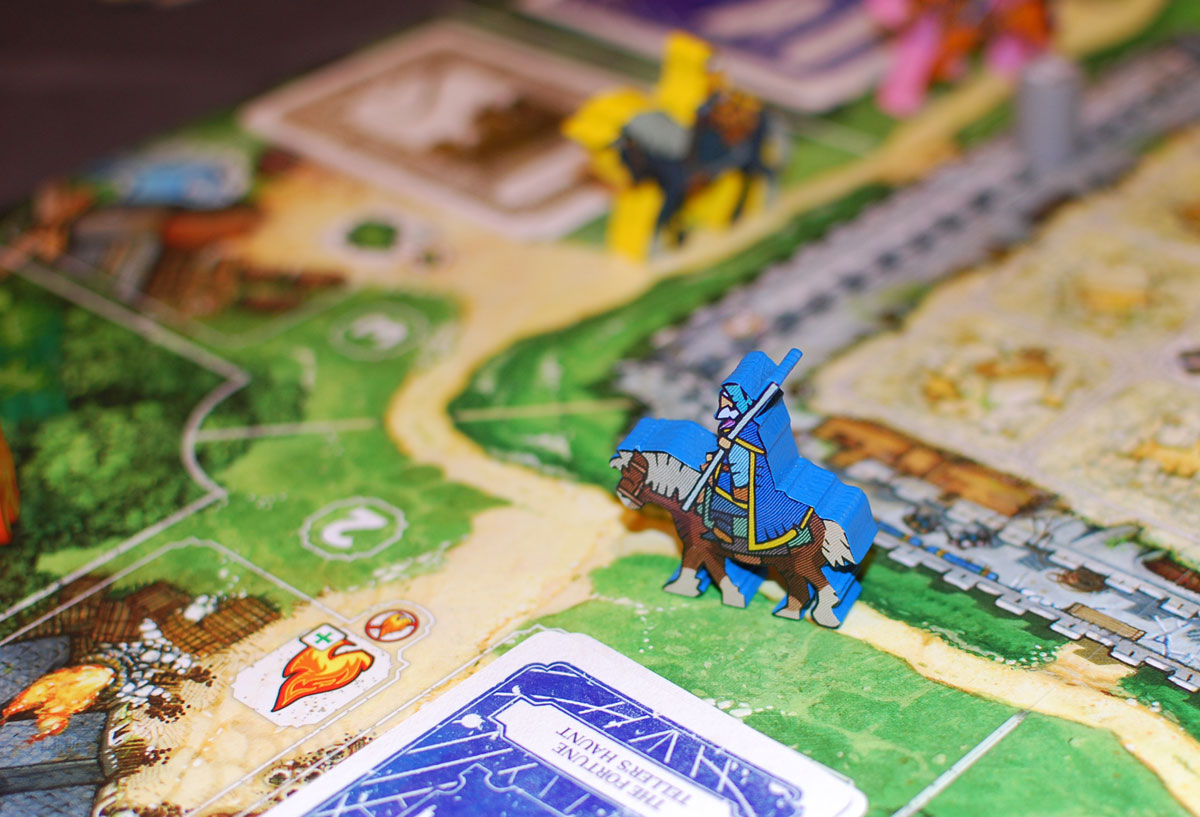
Because you’re generally limited to two actions per turn, and you can’t repeat actions, you can’t just camp out at a site and just plow through the incidents there to get it secured. But it can also feel inefficient to spend one of your precious actions each turn just to move. If you can park yourself somewhere and call on the community and experience an incident each turn, that’s ideal … assuming that other problems don’t crop up elsewhere, or you don’t end up racing off to a perilous region.
The incidents themselves can have rewards that are worth pursuing, but it depends on the circumstances. Some will let you clear the next incident card if you succeed—great if you’re close to securing a region, but wasted if it was already the last card there. Others can award resources, defense, or prestige, saving you a trip across the board to get them from the communities. Of course, that’s assuming you succeed—there are also plenty of negative consequences for failure, from losing health to damaging buildings to losing prestige or defense (which could cost you the game).
If you max out your defense, each time you get more defense you can remove an incident card. This seems like a cool strategy, but so far it hasn’t worked the times I’ve tried it, in part because we’ve hit various things that remove defense just when we’re getting close. I’ve had slightly better luck maxing out prestige—each time you go over, you get a treasure—but that’s not as directly useful. Treasure is a resource that is sometimes specifically required, but mostly you go to the marketplace region and trade it for other things; it’s not a wild resource that can be spent in place of other things.
There’s a mix of ranger powers, two for each of the professions (craftsman, soldier, scholar, traveler), and of course making the best use of these is important. The rangers have different amounts of total health, and—more importantly—different values at which they get fatigued and can no longer use their special abilities. For some of the rangers, losing a single health means you can’t use your ability, so you really have to think hard about whether to exert yourself for a success. Maeva never loses health on soldier tests—but that’s only helpful if you manage to find soldier tests for her to do. Conrad is allowed to repeat the same action on his turn. Berenice gets a bonus build action if she’s at the fortress. Assembling a team that can work together is part of the strategy.
The adversity track is an interesting aspect, too. Most of the faces on the adversity die move the tracker one space, so typically you’ll get 4 rounds per page of the chronicle, with one incident, one problem, and one event. If you roll the “stay,” you trigger the same thing again—this could be bad if you’re already in peril or have a lot of problems on the board, and sometimes you’ll wish you could skip over a space. On the other hand, if you roll “move twice” too many times, you may not have enough rounds to complete your assignment. The temple building lets you re-roll the adversity die and the location die once per turn—but is it worth re-rolling? Sometimes it’s not obvious what might be better.
All of this adds up to an eye-catching game that immerses you in an adventure story for about an hour or so. I’m giving Oltréé our GeekDad Approved seal, and I look forward to playing it some more!
For more information, visit the Hachette Boardgames website.
Click here to see all our tabletop game reviews.
![]() To subscribe to GeekDad’s tabletop gaming coverage, please copy this link and add it to your RSS reader.
To subscribe to GeekDad’s tabletop gaming coverage, please copy this link and add it to your RSS reader.
Disclosure: GeekDad received a copy of this game for review purposes.
